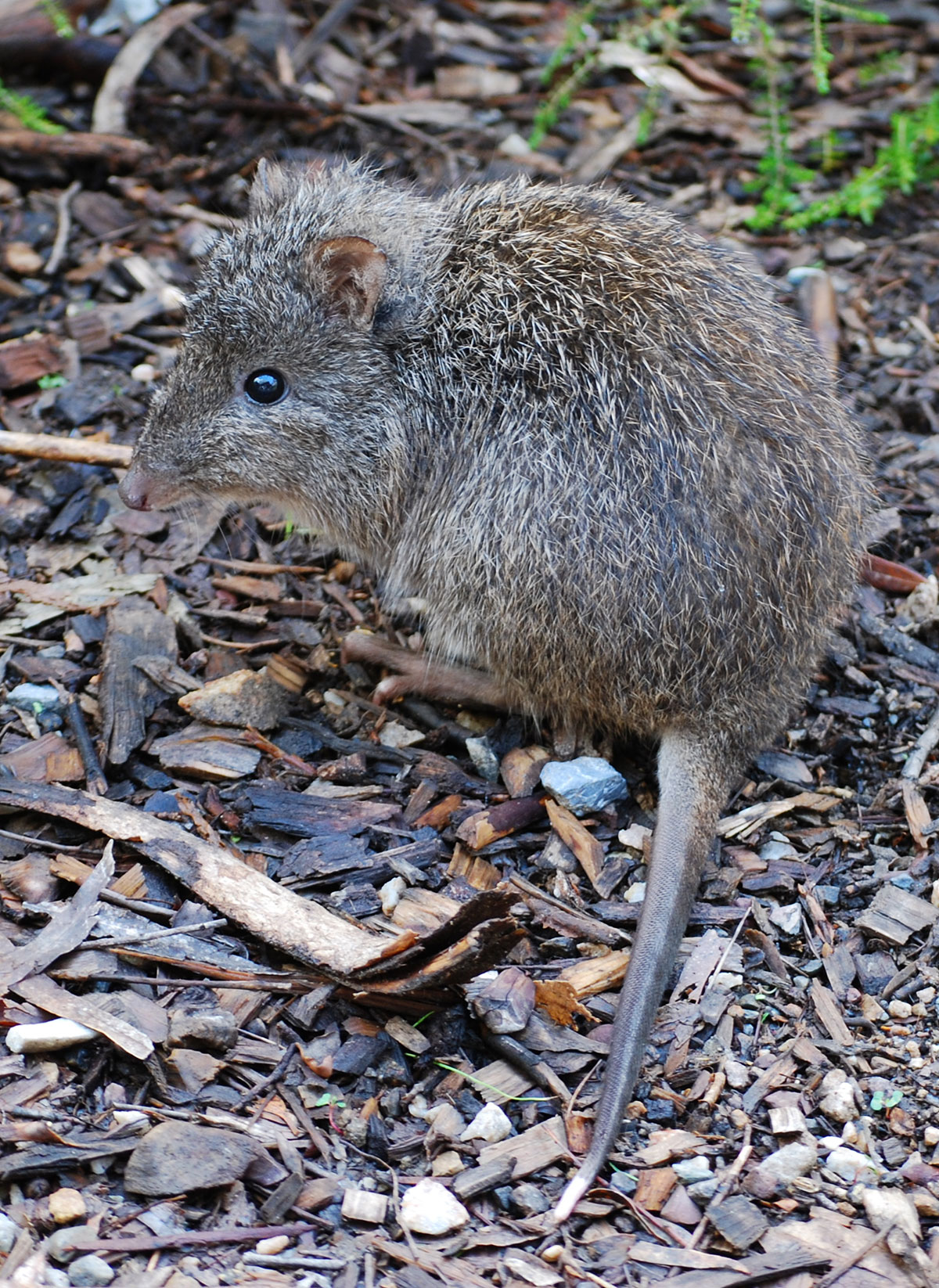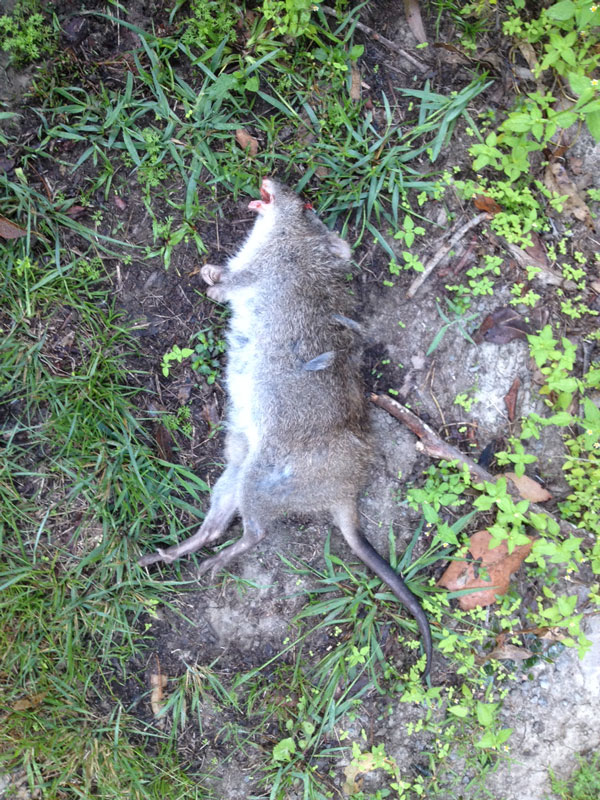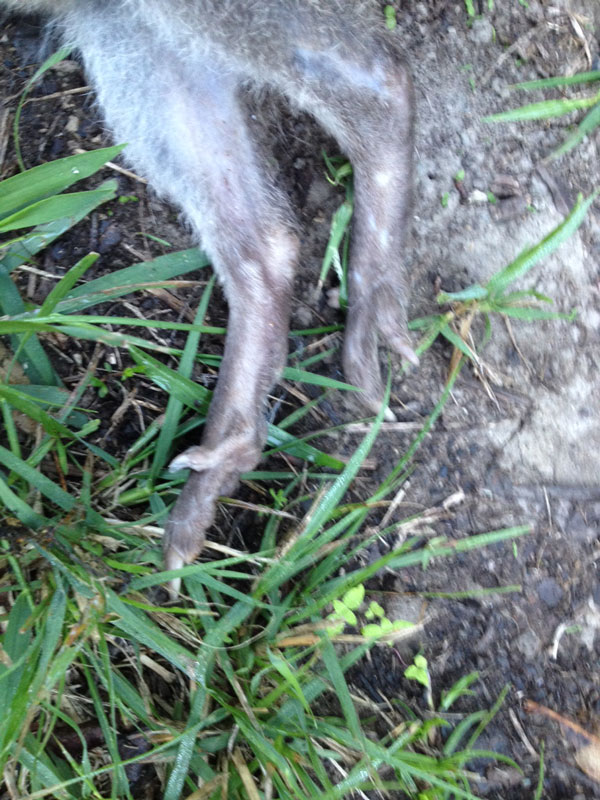Unfortunately many of us who regularly drive through bushland and rural areas become desensitised to the occasional, non-descript lump of fur or feathers on the side of the road marking another wildlife vehicle strike victim. But perhaps we should take more notice, despite the unsavoury nature of this task.
Road kill provides a static record of species presence, and in some cases, presents an ability to physically measure certain traits, and accumulate data trends over time at certain sites. Persistent data at a site/s can be used to drive other initiatives to reduce future impacts, such as speed reductions, warning signage, or wildlife crossing solutions such as rope bridges or underpasses. And just occasionally, a second look can yield an exciting record.

A captive Long-nosed Potoroo. Photo above and far right by Peripitus, Wikimedia Commons CC BY-SA 2.5.
I was recently travelling through the outskirts of Samford to a work function, and noted a dead, grey furry critter in the opposite lane. As I passed it occurred to me that it didn’t look quite right. Obviously the impact has caused significant damage, but certain characteristics just didn’t gel. After turning around and finding a safe place to stop, I retrieved the creature from the road to take a closer look.
The animal had recently been hit, probably within the last 8 hours so was still in reasonably good condition (for road kill). It was about the size of bandicoot, although maybe a bit longer. Although unlike a bandicoot, this animal had an obvious thick, black solid tail and large back legs with long feet – more like a hopping mammal such as a wallaby or bettong, which are able to stand on their hind legs. Bandicoots in contrast always use their four legs to walk or run. The front legs were short, but were armed with long curved claws, seemingly for digging.

This unfortunate Long-nosed Potoroo was found roadside near Samford. It was carefully collected, frozen and taken to the Queensland Museum.

Note the thick, dark tail and strong hind legs. Photos by Darren McPherson.
I wondered if it could be a potoroo, but I had never seen one before, so I wasn’t quite sure. I took two photographs on my smart phone and emailed them to a colleague to see if they knew what it was. I got back into my car and drove o to my all-day meeting in the city.
Sure enough, by the time I got to my meeting, my colleague had been in touch with a few experts who had all confirmed that indeed the road killed animal was a Long-nosed Potoroo, a threatened species with only limited populations in South East Queensland. After numerous emails and phone calls, someone living at Mt Glorious agreed to head down the mountain to look for this animal. They successfully located it, double-bagged it and popped it in their freezer.
Potoroo researcher at the Sunshine Coast University, Dr Scott Burnett, asked the potoroo’s caretakers to measure the potoroo’s neck size, so that correct sized radio-tracking collars could be purchased for the Reesville research project. This potoroo was then given to the Queensland Museum whereby they can take genetic material, record measurements or keep it is a study skin or taxidermied product for education and research.
It is hard to be prepared for every contingency in terms of wildlife and road strikes, but some basics to consider having in your car may include:
- A blanket for throwing over and subduing injured wildlife.
- A large heavy duty garbage bag and ties (for specimen collection and transport).
- A contact list of local wildlife carers so you know who to contact, especially at odd hours.
A captive Long-nosed Potoroo. Photo above and far right by Peripitus, Wikimedia Commons CC BY-SA 2.5.
• A smart phone or camera for taking pictures of the animal and recording location (either take photos of surrounding area so you could determine the location on a map or take a GPS reading).
• Gloves and hand sanitiser.
Always remember safety first when handling wild animals, especially if they are injured. Wild animals will bite, scratch, kick and whip their tails if they can. If you do not feel comfortable handling live animals, don’t! Just call a wildlife carer. If the animal is dead and you determine that it could
be a useful specimen for the Queensland Museum, pick it up and place it carefully in a garbage bag. Ensure that you either wear gloves or wash your hands thoroughly afterwards. Double wrap the specimen in two garbage bags and place in a freezer as soon as possible. Firmly attach a label
on the bag with the following information: date of collection, exact location of where it was collected, your name and contact details and the species name (if known).
It may not be a pleasant job, but recording or collecting road kill animals can offer important information for researchers and can help us all learn more about, and ultimately protect, our wildlife.
Article by Darren McPherson Land for Wildlife Officer Somerset Regional Council

I think l have a potoroo living behind my unit in carrara. Tried to take photo but it just hopped away.